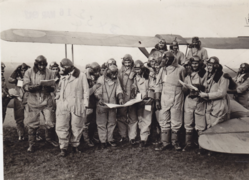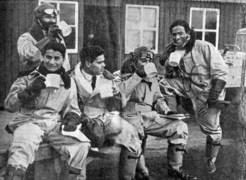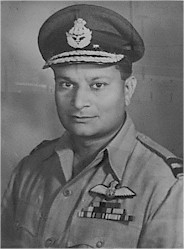Air Vice Marshal Ranjan Dutt, VrC (30 September 1921 or 1922 – 13 August 2009) was a former air officer of the Indian Air Force. He last served as the Air Officer Commanding-in-Chief Eastern Air Command. Prior to that, he was the managing director of Hindustan Aeronautics Limited.
In 1940 Dutt was one of the 24 Indian pilots seconded to the UK for operational training and squadron service. There he was selected for fighter training and subsequently spent the summer of 1941 protecting convoys through the English Channel and flying Hurricanes with No. 32 Squadron RAF after the Battle of Britain. He served in North Africa and the Middle-East in the latter part of that year before returning to India to join No. 4 Squadron IAF at Peshawar, North-West Frontier. There, he flew sorties from Miranshah in the Datakhel operations. In June 1944 he became one of the first Indian flight instructors at a training unit in Risalpur. The following year he completed a flight leader course at RAF Tangmere in the UK, and then joined No. 8 Squadron IAF in Mingaladon as a flight commander.
Later, in a senior post at the Operational group, Dutt led several air missions in the Indo-Pakistani War of 1947–1948. On 26 January 1950 he was awarded the second Vir Chakra.
Early life and education
Ranjan Dutt was born on 30 September 1921, or in 1922. He was educated at Prince of Wales Royal Indian Military College, Dehradun, India. At the age of 16 he gained his civilian pilot "A" licence after taking private lessons.
Military career
Second World War
In August 1940, Dutt was selected from the fourth pilot's course at the initial training wing in Lahore to travel with another 23 Indian pilots to the UK for operational training and squadron service in preparation to assist in the Battle of Britain. They became known as the X-squad. The youngest of the batch, he later admitted that he submitted an incorrect date of birth in order to qualify for the place. The group's activities received widespread media coverage. The P&O liner SS Strathallan's passenger list records the group's arrival at Liverpool, England, on 6 October 1940. On arrival at London on 8 October, Dutt and his group were welcomed by the Air Minister, Sir Archibald Sinclair, who handed each a note concluding "we shall be proud to have you fighting by our side". That day the group were posted to RAF Uxbridge, and subsequently Dutt was sent with most of the others to No. 12 Elementary Flying Training School RAF at Prestwick to train on Tiger Moths. He completed his advanced training at No. 9 Service Flying Training School at RAF Hullavington, Wiltshire, and received his wings on 16 April 1941. Eight of the Indians, including Dutt, were selected for fighter training at No. 56 OTU at RAF Sutton Bridge. Subsequently, he spent near four months protecting convoys through the English Channel and flying Hurricanes with No. 32 Squadron RAF after the Battle of Britain.
After a year in the UK Dutt was posted to No. 94 Squadron RAF, based in Egypt. Along with Mahinder Singh Pujji, Mian Mohd Latif and Edwin Nazirullah from his initial group, he served in North Africa and the Middle-East in the latter part of 1941. After returning to India he joined No. 4 Squadron IAF at Peshawar, North-West Frontier. No. 4 Squadron was officially formed on 1 February 1942 and at first consisted largely of some of that first batch of 24 Indian pilots of 1940; Pujji, Latif, Nazirullah, Shiv Dev Singh, and Om Prakash Sanghi. They obtained four Westland Lysanders from Lahore and completed a move to Kohat by 23 February 1942. By March 1942, the squadron had 19 officers and 40 pilots. In May 1942, Dutt flew several sorties from Miranshah in the Datakhel operations; these lasted until mid-August. At the end of 1942 he was posted as flight officer to No. 1 Squadron IAF, also known as the Tigers, at Trichinopoly.
In June 1944, Dutt became one of the first Indian flight instructors at No. 151 (Fighter) Operational Training Unit RAF, Risalpur. He served in the Burma campaign, flying Hurricanes. For a short while he was posted to No. 20 Squadron RAF Arakan and saw action in the Battle of Imphal. He later joined the newly raised No. 10 Squadron IAF in 1944 and replaced Bob Doe's Canadian flight commander.. Dutt remained there for the squadron's first operational tours. In August 1945, after completing a flight leader course at RAF Tangmere in the UK, Dutt joined No. 8 Squadron IAF in Mingaladon, as flight commander. There, he substituted the Vic formation with the finger-four formation. In March 1946, Dutt was promoted to squadron leader of No. 1 Squadron RIAF. Towards the beginning of 1947, under Dutt's command, the Tigers converted to the Hawker Tempest.
-
 Dutt's group arrive at a London station 8 October 1940
Dutt's group arrive at a London station 8 October 1940
-
 At Prestwick, Dutt second from right in front row holding a map
At Prestwick, Dutt second from right in front row holding a map
-
 At Prestwick, Dutt seated first on left
At Prestwick, Dutt seated first on left
Post-Independence
In August 1947, with the partition of India, Dutt moved to India. In November, he was appointed Senior Air Staff Officer (SASO) of the No. 1 Operational group at Palam; he led several air missions in the Indo-Pakistani War of 1947–1948, including a strike sortie on Kishanganga Bridge. On 1 August 1948, he was promoted to the acting rank of group captain and continued as SASO, No. 1 Operational Group.
Vir Chakra
On 26 January 1950, with India becoming a republic, the first gallantry awards were announced. Dutt was awarded the Vir Chakra for gallantry for his role in the Indo-Pakistani War of 1947, with the effective date of award of 2 November 1948.
The citation reads as follows:
Gazette Notification: 2 Pres 50, 26-1-50
Effective Date of Award: 02 Nov 1948
CITATION
GROUP CAPTAIN (NOW AIR VICE MARSHAL) RANJAN DUTT
1594 G.D.(P)
Group Captain (Now Air Vice Marshal) Ranjan Dutt (1594), while serving as S.A.S.O Headquarters No. 1 (Operational) Group, took every opportunity to take part in the Kashmir Operations.
This officer had on three occasions led, with distinction attacks on KISHENGANGA Bridge. The first attack resulted in temporary stoppage of movement of enemy troops and supplies over the bridge. When movement again resumed after the bridge had been repaired, reinforced with heavy protective medium 'Flak' he led another formation for the second time. To facilitate his formation to attack, he went low to straff and silenced the gun positions. In spite of his aircraft being hit by enemy fire, he attacked with precision and knocked out one of the gun positions.
Leading a formation of four aircraft, he again attacked the Kishenganga Bridge, undeterred by the fact that his aircraft had been shot up badly the day before. Although his aircraft was damaged by heavy anti-aircraft fire in this sortie also, he attacked with precision and determination and scored a direct hit on the bridge, causing considerable damage to it. After the mission, by great skill, he brought his badly damaged aircraft back safely to the base. He also carried out highly successful reconnaissance sorties and attacks on Gilgit and Skardu.
For the outstanding services rendered by him during the Kashmir Operations, he has been awarded the Vir Chakra.
Later career
On 1 July 1951, Dutt was appointed Commanding Officer of the No. 1 Air Force Academy (No. 1 AFA) in Ambala. In September, he led the movement of the Academy to Secunderabad. He graduated in 1952 from RAF Staff College, Andover, with a thesis on "Commonwealth Defence". On 1 April 1953, he was made substantive group captain. In 1957, he contributed to the evaluation for the purchase of Hawker Hunters for the IAF. In October 1954, he moved to Air HQ, having been appointed Director, Operations.
Air rank
After a four-year tenure, on 28 May 1958, he was promoted to the acting rank of air commodore and appointed Air Officer-in-Charge Policy and Plans at Air HQ. This was a short tenure; in March next year, he took over as the Air officer commanding Training Command at Bangalore. In April 1960, the post was upgraded to a two-star rank and rechristened Air Officer Commanding-in-Chief. Dutt was promoted to the acting rank of air vice marshal.
By the end of the year, Dutt was appointed the managing director of Hindustan Aeronautics Limited (HAL). At HAL, he led the procurement of HAL HF-24 Maruts designed by Kurt Tank, and later MiG-21s.
After a long six-year stint as the MD of HAL, in October 1966, Dutt was appointed Air Officer Commanding-in-Chief Eastern Air Command at Shillong. He served as the AOC-in-C for two years. At the completion of tenure in air rank, he retired on 31 May 1968.
Personal life
Dutt married Claude Marie De Cavey from Belgium. Their daughter is Ayesha Dutt, who is married to Jackie Shroff, and his grandson is Tiger Shroff.
However, Dutt was first married to Ratina Rawlley. The pair had one son - Shunith Dutt. Ranjan Dutt lived in the care of Shunith in the years leading up to, and including, his death.
Awards and decorations
Dutt had served North Africa and the Middle-East long enough to wear the Africa Star. Later, he qualified for the Air Crew Europe Star. On 26 January 1950 he was awarded the Vir Chakra.
Death
Dutt died on 13 August 2009 in Chennai.
Footnotes
- He may have come to the end of his term of duty or been promoted.
- No. 1 Squadron IAF was at first raised in 1933, carried prefix Royal between 1945 and 1950, came under Pakistan at partition (1947), disbanded just short of independence and then recreated by India, being formed by 15 Squadron in 1953.
References
- ^ "Air Vice Marshal Ranjan Dutt: wartime RAF pilot and Indian Air Force chief". The Times. Archived from the original on 27 December 2022. Retrieved 27 December 2022.
- ^ Nair, K.S. "Air Vice Marshal Ranjan Dutt (1594)". Archived from the original on 29 December 2022. Retrieved 28 December 2022.
- ^ Nair, K.S. 2019. Chapter 2. 1939-40: War in Europe, pp. 42-70
- ^ Goodrum, Alastair (2019). "6. A foreign field and English sky". School of Aces: The RAF Training School that Won the Battle of Britain. Amberley Publishing Limited. pp. 130–150. ISBN 978-1-4456-8618-9.
- "UK and Ireland, Incoming Passenger Lists, 1878-1960". 1940 Passenger list. 9 October 1940. Retrieved 29 December 2022 – via ancestry.co.uk.
- "Air Minister welcomes Indian pilots". The Scotsman. 9 October 1940. p. 2 – via British Newspaper Archive.
- ^ "Service Record for Air Vice Marshal Ranjan Dutt 1594". Bharat Rakshak. Archived from the original on 27 December 2022. Retrieved 27 December 2022.
- ^ Nair, K.S. 2019. Chapter 3. 1941: And then there were three - the raising of No 2 and 3 Squadrons, p. 99
- ^ Mohan, PVS Jagan (2010). "No.4 Squadron (Feb 1942-June 1943)". The Westland Lysander in Indian Air Force Service. Hydrabad: Jagan Pillarisetti. pp. 21–32.
- ^ "Press information" (PDF). Government of India. New Delhi. 1 September 1966. Archived from the original (PDF) on 28 December 2022. Retrieved 28 December 2022.
- ^ Nair, K.S. 2019. Chapter 6. 1944: Back to Burma, pp. 213-251
- ^ Doe, Helen (2015). "8. The battle over the Burmese jungle". Fighter Pilot: The Life of Battle of Britain Ace Bob Doe. Stroud, Gloucestershire: Amberley Publishing Limited. p. 162. ISBN 978-1-4456-4612-1.
- ^ Nair, K.S. 2019. Chapter 8. 1945: Return to Rangoon, pp. 314-320
- Nair, K.S. (14 August 2020). "The Real End of World War II and the Indian Servicemen Who Had a Ringside View of It". The Wire. Archived from the original on 29 December 2022. Retrieved 29 December 2022.
- Iqbal, Aashique Ahmed (2022). "2. Ittehad mein shakti (strength in unity): Aviation and the partition of India 1946-1947". The Aeroplane and the Making of Modern India. Oxford University Press. pp. 119–122. ISBN 978-0-19-286420-8.
- Singh, Ranbir (2014). Marshal Arjan Singh, DFC Life and Times. Prabhat Prakashan. pp. 56–57. ISBN 978-93-5048-896-6.
- "Gallantry Awards | Ministry of Defence, Government of India". www.gallantryawards.gov.in. Archived from the original on 4 January 2023. Retrieved 4 January 2023.
- Bowman, Martin W. (2021). "1. Hunter hysteria". The Men Who Flew the Hawker Hunter. Yorkshire: Pen and Sword Aviation. p. 25. ISBN 978-1-5267-0572-3.
- "Service Record for Air Vice Marshal Ranjan Dutt 1594 GD(P) at Bharat Rakshak.com". Bharat Rakshak. Retrieved 4 January 2023.
- ^ "Did you know Tiger Shroff's handsome looks come from his Gujarati, Turk, Belgian roots?". Hindustan Times. 2 March 2021. Archived from the original on 1 January 2023. Retrieved 1 January 2023.
- Nair, K.S. 2019. Chapter 9. 1945: Post-surrender ops and 1946, p. 333
- "TDA - The Defence Aspirant Academy". www.tdaacademy.in. Archived from the original on 29 December 2022. Retrieved 29 December 2022.
Bibliography
- Nair, K. S. (2019). The Forgotten Few; The Indian Air Force in World War II. Noida, UP: Harper Collins. pp. 42–70. ISBN 978-93-5357-067-5.
Further reading
- Sapru, Somnath (15 July 2014). Combat Lore: Indian Air Force 1930-1945: Indian Air Force 1930-1945. New Delhi: KW Publishers Pvt Ltd. ISBN 978-93-85714-34-4.
External links
- Arrival at London, 8 October 1940 on YouTube (British Pathé)
- Indian Air Force Volunteer Reserve Pilots at RAF Prestwick 1940 on YouTube (British Pathé)
- "Indian Air Force Gallery". Bharat Rakshak. Retrieved 31 December 2022.
| Military offices | ||
|---|---|---|
| Preceded byEdwin Nazirullah | Commanding Officer No. 1 Squadron IAF 1946–1947 |
Succeeded byAnand Ramdas Pandit |
| Preceded byK. Jaswant-Singh | Air Officer Commanding-in-Chief Training Command 1959–1960 |
Succeeded bySurendra Nath Goyal |
| Preceded byYeshwant Vinayak Malse | Air Officer Commanding-in-Chief Eastern Air Command 1966–1968 |
Succeeded byHirendra Nath Chatterjee |
